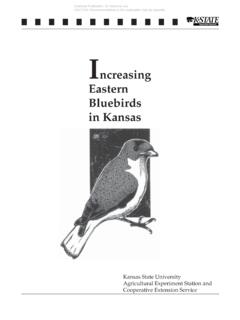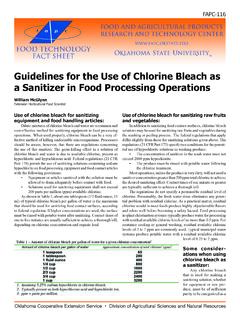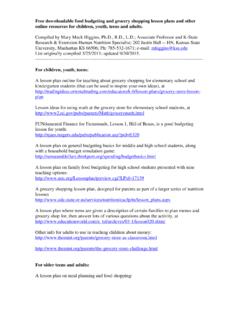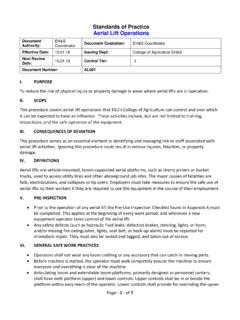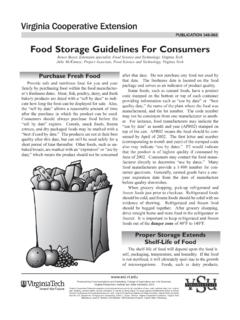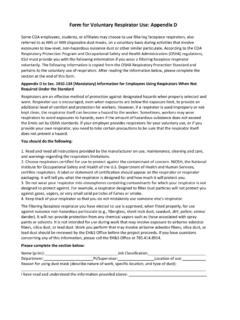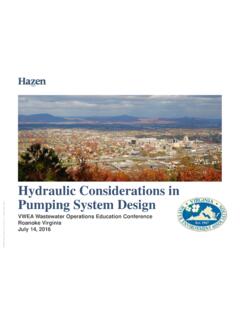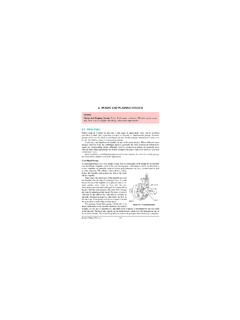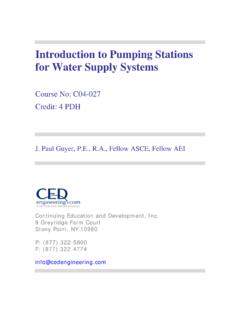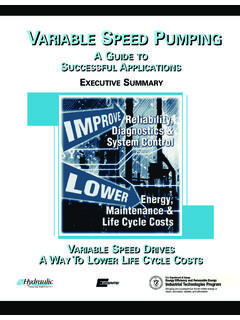Transcription of EVALUATING ENERGY USE FOR PUMPING IRRIGATION WATER
1 Proceedings of the 23rd Annual Central Plains IRRIGATION Conference, Burlington, CO., February 22-23, 2011 Available from CPIA, 760 N. Thompson, Colby, Kansas 104 EVALUATING ENERGY USE FOR PUMPING IRRIGATION WATER Derrel L. Martin, Tom W. Dorn, Steve R. Melvin, Alan J. Corr, William L. Kranz Associate Professor Biological Systems Engineering University of Nebraska Haskell Agricultural Laboratory Concord, Nebraska VOICE: 402-584-3857 FAX: 402-584-3859 ENERGY USE IN IRRIGATON IRRIGATION of million acres of cropland accounts for a large portion of the ENERGY used in Colorado, Nebraska, and Kansas. Analysis of data from the 2008 USDA Farm and Ranch IRRIGATION Survey shows that the average ENERGY use for irrigating crops in Nebraska alone would be equivalent to about 340 million gallons of diesel fuel annually if all pumps were powered with diesel engines.
2 While use varies depending on annual precipitation, average yearly ENERGY consumption in Nebraska is equivalent to about 40 gallons of diesel fuel per acre irrigated. The cost to irrigate a field is determined by the amount of WATER pumped and the cost to apply a unit (acre-inch) of WATER (Figure 1). Factors that determine PUMPING costs include those that are fixed for a given location (in the ovals in Figure 1) and those that producers can influence. The factors that producers can influence include: IRRIGATION scheduling, application efficiency, efficiency of the PUMPING plant, and the PUMPING pressure required for center pivot system. PUMPING costs can be minimized by concentrating on these factors. Irrigators may also consider changing the type of ENERGY used to power IRRIGATION if they determine that one source provides a long-term advantage.
3 IRRIGATION scheduling can minimize the total volume of WATER applied to the field. Demonstration projects in central Nebraska have indicated that inches of WATER can be saved by monitoring soil WATER and estimating crop WATER use rates. The goal is to maximize use of stored soil WATER and precipitation to minimize PUMPING . Improving the efficiency of WATER application is a second way to conserve ENERGY . WATER application efficiency is a comparison between the depth of WATER pumped and the depth stored in the soil where it is available to the crop. IRRIGATION systems can lose WATER to evaporation in the air or directly off plant foliage. WATER is also lost at the soil surface as evaporation or runoff. Excess IRRIGATION and/or rainfall may also percolate through the crop root zone leading to deep percolation.
4 For center pivots, WATER application efficiency is based largely on the sprinkler package. high pressure impact sprinklers direct WATER upward into the air and thus there is more opportunity for wind drift and inaddition, high pressure impact sprilonger than low pressure spray heads mounted on drop tubes. The difference in application time results in less evaporation directly from the foliage for low pressure spray systems. Caution should be used so tresult with a sprinkler package. Good IRRIGATION scheduling should minimize deep percolation. Figure 1. Diagram of factors affecting IRRIGATION PUMPING costs. ENERGY use can also be reduced by lowering the operating pressurirrigation system. One must keep in mind that lowering the operating pressure will reduce PUMPING cost per acreresults in an increased WATER application rate for a center pivot.
5 The key is to ensure that the operating pressure is sufficient to eliminate the potential for surface runoff. Field soil characteristics, surface roughness, slope and tillage combine to control how fast WATER can be applied to the soil surface before surface runoff occurs. If WATER moves from the point of application, the savings in ENERGY resulting from a reduction in operating pressure need to pump more WATER to ensure that all portions of the field receive at least the desired amount of WATER . Finally, ENERGY can be conserved by ensuring that the PUMPING plant is operating as efficiently as possible. Efficient PUMPING plants require properly matched pumps, systems and power sources. By keeping good records of the amount of WATER pumped and the energ105 ivots, WATER application efficiency is based largely on the sprinkler package.
6 high pressure impact sprinklers direct WATER upward into the air and thus there is more opportunity for wind drift and in-air evaporation. In addition, high pressure impact sprinklers apply WATER to foliage for 20-longer than low pressure spray heads mounted on drop tubes. The difference in application time results in less evaporation directly from the foliage for low pressure spray systems. Caution should be used so that surface runoff does not result with a sprinkler package. Good IRRIGATION scheduling should minimize deep Diagram of factors affecting IRRIGATION PUMPING use can also be reduced by lowering the operating pressure of the IRRIGATION system. One must keep in mind that lowering the operating pressure will reduce PUMPING cost per acre-inch, but reducing the pressure almost always results in an increased WATER application rate for a center pivot.
7 The key is to hat the operating pressure is sufficient to eliminate the potential for surface runoff. Field soil characteristics, surface roughness, slope and tillage combine to control how fast WATER can be applied to the soil surface before ater moves from the point of application, the savings in ENERGY resulting from a reduction in operating pressure is counterbalanced need to pump more WATER to ensure that all portions of the field receive at least the desired amount of WATER . lly, ENERGY can be conserved by ensuring that the PUMPING plant is operating as efficiently as possible. Efficient PUMPING plants require properly matched pumps, systems and power sources. By keeping good records of the amount of WATER pumped and the ENERGY used, you can discover if extra money is being ivots, WATER application efficiency is based largely on the sprinkler package.
8 high pressure impact sprinklers direct WATER upward into the air evaporation. In -40 minutes longer than low pressure spray heads mounted on drop tubes. The difference in application time results in less evaporation directly from the foliage for low hat surface runoff does not result with a sprinkler package. Good IRRIGATION scheduling should minimize deep Diagram of factors affecting IRRIGATION PUMPING costs. e of the IRRIGATION system. One must keep in mind that lowering the operating pressure inch, but reducing the pressure almost always results in an increased WATER application rate for a center pivot. The key is to hat the operating pressure is sufficient to eliminate the potential for surface runoff. Field soil characteristics, surface roughness, slope and tillage combine to control how fast WATER can be applied to the soil surface before ater moves from the point of application, the savings in is counterbalanced by the need to pump more WATER to ensure that all portions of the field receive at least lly, ENERGY can be conserved by ensuring that the PUMPING plant is operating as efficiently as possible.
9 Efficient PUMPING plants require properly matched pumps, systems and power sources. By keeping good records of the amount of if extra money is being 106 spent on PUMPING the WATER and how much you can afford to spend to fix components that are responsible for increased costs. This document describes a method to estimate the cost of PUMPING WATER and to compare the amount of ENERGY used to that for a well maintained and designed PUMPING plant. The results can help determine the feasibility of repairs. ENERGY REQUIREMENTS The cost to pump IRRIGATION WATER depends on the type of ENERGY used to power the PUMPING unit. Electricity and diesel fuel are used to power IRRIGATION for about 76% of the land irrigated in the region. Nebraska uses electricity or diesel fuel to power PUMPING plants used to irrigate approximately million acres of cropland.
10 Natural gas and Propane are used on about 20 and 4% of the land in the 3-state region, respectively. Kansas leads the region in the use of natural gas for PUMPING plant power with approximately million acres irrigated. Very little land is irrigated with gasoline powered engines. The cost to pump an acre-inch of WATER depends on: The work produced per unit of ENERGY consumed, The distance WATER is lifted from the groundwater aquifer or surface WATER source to the pump outlet, The discharge pressure at the pump outlet, The performance rating of the PUMPING plant, and The cost of a unit of ENERGY . The amount of work produced per unit of ENERGY depends on the source used to power the pump (Table 1). One gallon of diesel fuel will generate about 139,000 BTU of ENERGY if completely burned.
